The global walking type sprinkler systems market, valued at USD 1.7 billion in 2025, is projected to reach USD 2.4 billion by 2035, expanding at a CAGR of 3.7% and recording an absolute increase of USD 700 million over the forecast period. The walking type sprinkler systems market is expected to grow by approximately 1.4X, driven by increasing demand for walking type sprinkler systems in agricultural irrigation, horticultural landscaping, and turf maintenance applications. The growth trajectory reflects a broader movement toward semi-automated irrigation systems that offer mobility, water efficiency, and adaptability across various terrains, enabling farmers and facility managers to optimize water distribution and reduce manual labor dependency.
The agricultural sector represents the largest share of the walking type sprinkler systems market, accounting for the widespread adoption of mobile irrigation mechanisms across cereal, vegetable, and fruit cultivation zones. The shift toward walking or traveling sprinklers stems from their ability to deliver uniform coverage across large fields without requiring fixed pipelines or complex installation infrastructure. The demand for walking type sprinkler systems is particularly strong in regions where electricity supply is limited, as motorized models with adjustable walking speeds and pressure control mechanisms provide operational flexibility under varying water pressures. Farmers are increasingly favoring portable sprinkler units with lightweight aluminum booms and corrosion-resistant materials that ensure durability and ease of repositioning across multiple plots.
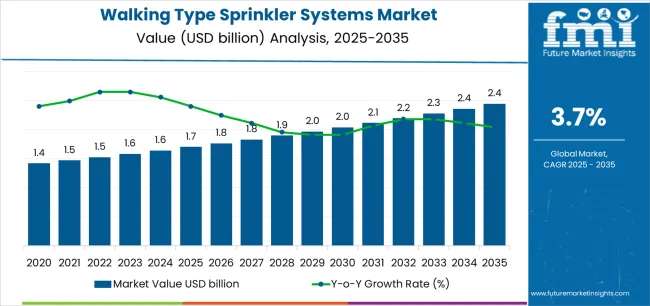
Orchard operations' investments in modern irrigation infrastructure are further strengthening market prospects, as fruit production facilities, vineyard operations, and specialty crop growers require reliable irrigation systems that can navigate varied terrain and deliver precise water applications. The agricultural modernization efforts in developing regions, combined with the growth of commercial farming operations, are driving adoption of walking type sprinkler technology for large-scale field irrigation, permanent crop watering, and specialty agricultural applications. Regional agrarian development programs, particularly in water-stressed regions, are creating new opportunities to deploy irrigation systems efficiently across diverse farming environments.
The development of the walking-type sprinkler systems market is supported by continuous innovation in drive mechanisms, water distribution technologies, and control systems that enhance operational reliability and irrigation uniformity. Manufacturers are focusing on developing versatile walking sprinkler configurations that offer flexibility across different field sizes and crop requirements, enabling cost-effective solutions for varied agricultural needs. Environmental considerations and water conservation objectives are influencing product development, with an emphasis on pressure-regulated systems, uniform-application technologies, and weather-responsive controls that optimize water use. The increasing complexity of agricultural operations and the need for labor-efficient farming systems are positioning walking type sprinkler systems as essential components of modern agrarian infrastructure.
Between 2025 and 2030, the walking type sprinkler systems market is projected to expand from USD 1.7 billion to USD 2.1 billion, resulting in a value increase of USD 334 million, which represents 45.5% of the total forecast growth for the decade. This phase of development will be shaped by increasing agricultural mechanization initiatives, growing emphasis on water conservation practices, and rising demand for labor-efficient irrigation systems in commercial farming operations. Agricultural producers and orchard operators are expanding their mechanized irrigation capabilities to address the growing demand for efficient and sustainable water management solutions that ensure crop productivity and environmental compliance.
| Metric | Value |
|---|---|
| Estimated Value in (2025E) | USD 1.7 billion |
| Forecast Value in (2035F) | USD 2.4 billion |
| Forecast CAGR (2025 to 2035) | 3.7% |
From 2030 to 2035, the walking type sprinkler systems market is forecast to grow from USD 2.1 billion to USD 2.4 billion, adding another USD 400.6 million, which constitutes 54.5% of the overall ten-year expansion. This period is expected to be characterized by the expansion of precision agriculture integration with automated irrigation management, the development of smart walking sprinkler systems with IoT connectivity and weather-responsive controls, and the growth of specialized applications in organic farming operations and high-value crop production. The growing adoption of sustainable agriculture principles and water stewardship strategies will drive demand for walking type sprinkler systems with enhanced water use efficiency and environmental performance features.
Between 2020 and 2025, the walking type sprinkler systems market experienced steady growth, driven by increasing agricultural labor shortages and growing recognition of mechanized irrigation technology as essential equipment for improving water management efficiency and crop production consistency across diverse farming and orchard applications. The walking type sprinkler systems market developed as agricultural managers and irrigation specialists recognized the potential for walking sprinkler technology to reduce manual labor requirements, improve irrigation uniformity, and support sustainable water management objectives while meeting production efficiency requirements. Technological advancement in drive systems and water distribution control began emphasizing the critical importance of maintaining consistent application rates and operational reliability in challenging agricultural environments.
Market expansion is being supported by the increasing global demand for efficient irrigation solutions driven by water scarcity challenges and agricultural intensification trends, alongside the corresponding need for mechanized irrigation equipment that can enhance water use efficiency, enable labor-cost reduction, and maintain consistent crop quality across various farms, orchards, and specialty agricultural applications. Modern agricultural operations and orchard managers are increasingly focused on implementing walking sprinkler solutions that can reduce water consumption, enhance operational efficiency, and provide consistent performance in varying climatic conditions.
The growing emphasis on sustainable agriculture and water conservation is driving demand for walking type sprinkler systems that can support precision irrigation delivery, enable weather-based scheduling, and ensure comprehensive water stewardship. Agricultural producers' preference for irrigation equipment that combines operational efficiency with environmental credentials and labor-saving capabilities is creating opportunities for innovative walking sprinkler implementations. The rising influence of precision agriculture adoption and climate-smart farming practices is also contributing to increased adoption of walking sprinkler systems that can provide superior irrigation uniformity without compromising operational flexibility or environmental compliance.
The walking type sprinkler systems market is segmented by installation type, application, and region. By installation type, the walking type sprinkler systems market is divided into mobile type, fixed type, and others. Based on application, the walking type sprinkler systems market is categorized into farms and orchards. Regionally, the walking type sprinkler systems market is divided into East Asia, Europe, North America, South Asia, Latin America, Middle East & Africa, and Eastern Europe.
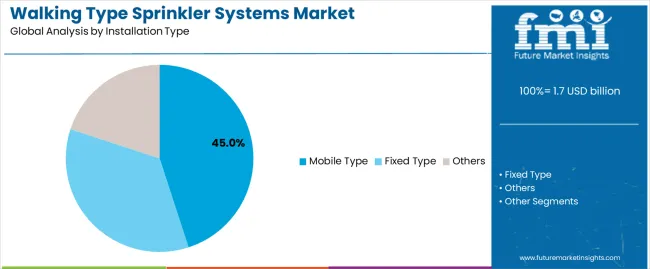
The mobile type installation segment is projected to maintain its leading position with a 45% market share in the walking type sprinkler systems market in 2025, reaffirming its role as the preferred configuration for flexible irrigation applications across diverse agricultural operations. Farms and orchard operators increasingly utilize mobile walking sprinklers for their superior operational flexibility, field-to-field mobility, and proven effectiveness in providing uniform irrigation coverage across varying field sizes and crop types. Mobile installation technology's proven effectiveness and application versatility directly address the industry requirements for adaptable irrigation solutions and efficient water management across diverse agricultural platforms and operational scenarios.
This installation segment forms the foundation of modern mechanized irrigation, as it represents the configuration with the greatest operational flexibility and established performance record across multiple agricultural applications and farm sizes. Agricultural sector investments in efficient irrigation technologies continue to strengthen adoption among farms and orchard operations. With operational pressures requiring improved water efficiency and reduced labor costs, mobile type walking sprinklers align with both productivity objectives and sustainability requirements, making it the central component of comprehensive agricultural irrigation strategies.

The farms application segment is projected to represent the 60% market share of walking type sprinkler systems demand in 2025, underscoring its critical role as the primary driver for walking sprinkler adoption across grain production, forage crops, vegetable cultivation, and general agricultural field operations. Farm operators prefer walking type sprinkler systems for irrigation due to their exceptional field coverage capabilities, water distribution uniformity, and ability to operate with minimal supervision while supporting production efficiency objectives and water conservation compliance. Positioned as essential equipment for modern farming operations, walking sprinkler systems offer both operational advantages and resource conservation benefits.
The segment is supported by continuous innovation in agricultural irrigation technology and the growing availability of advanced walking sprinkler models that enable superior irrigation performance with enhanced durability and reduced operational complexity. Additionally, farm operators are investing in comprehensive mechanized irrigation programs to support increasingly stringent water use regulations and economic pressures for improved farm productivity. As agricultural mechanization accelerates and environmental standards increase, the farms application will continue to dominate the market while supporting advanced irrigation practices and crop production optimization strategies.
The walking type sprinkler systems market is advancing steadily due to increasing demand for labor-efficient irrigation solutions driven by agricultural labor shortages and growing adoption of mechanized farming practices that require specialized irrigation technologies providing enhanced water use efficiency and operational automation benefits across diverse farms and orchard applications. However, the walking type sprinkler systems market faces challenges, including high capital investment requirements and maintenance costs, competition from alternative irrigation systems, including center pivot and drip irrigation technologies, and operational constraints related to field terrain limitations and power source availability. Innovation in energy-efficient drive systems and smart irrigation control technologies continues to influence product development and market expansion patterns.
The growing challenge of water scarcity in agricultural regions is driving demand for efficient irrigation technologies that address critical water management requirements, including reduced water consumption, improved application uniformity, and optimized irrigation scheduling capabilities. Agricultural operations require advanced walking sprinkler systems that deliver superior water use efficiency across multiple operational parameters while maintaining crop productivity and cost-effectiveness. Farm managers are increasingly recognizing the competitive advantages of mechanized irrigation integration for water conservation and operational sustainability, creating opportunities for innovative walking sprinkler designs specifically engineered for water-limited agricultural environments.
Modern walking type sprinkler manufacturers are incorporating precision agriculture capabilities and smart irrigation technologies to enhance water management performance, enable data-driven scheduling, and support comprehensive farm management through optimized application control and real-time monitoring systems. Leading companies are developing intelligent walking sprinkler systems with weather station integration, implementing remote control capabilities, and advancing automation technologies that optimize water application based on crop requirements and environmental conditions. These technologies improve irrigation efficiency while enabling new service opportunities, including precision water management programs, performance optimization consulting, and data-driven agronomic insights. Advanced digital integration also allows manufacturers to support comprehensive sustainability objectives and operational efficiency beyond traditional irrigation capabilities.
The expansion of sustainable agriculture practices and energy cost pressures is driving demand for energy-efficient walking sprinkler systems with low-pressure operation capabilities and reduced power consumption requirements. These advanced systems require innovative drive mechanisms and spray technologies with optimized energy utilization that accommodate varying operational conditions, creating premium market segments with differentiated value propositions. Manufacturers are investing in energy-efficient design capabilities and alternative power systems to serve environmentally conscious agricultural operations while supporting innovation in sustainable irrigation and reducing operational costs.
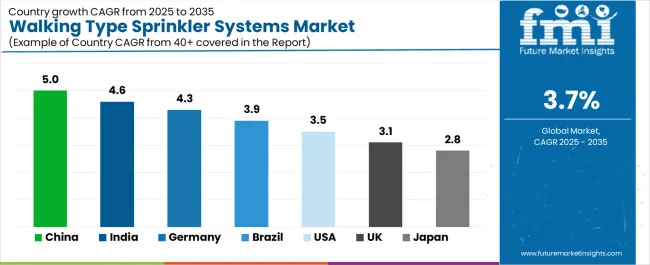
| Country | CAGR (2025-2035) |
|---|---|
| China | 5% |
| India | 4.6% |
| Germany | 4.3% |
| Brazil | 3.9% |
| United States | 3.5% |
| United Kingdom | 3.1% |
| Japan | 2.8% |
The walking type sprinkler systems market is experiencing solid growth globally, with China leading at a 5% CAGR through 2035, driven by massive agricultural modernization programs, expanding commercial farming operations, and government initiatives supporting mechanized irrigation adoption across grain production regions. India follows at 4.6%, supported by growing agricultural mechanization, expanding irrigation infrastructure development, and increasing emphasis on water-efficient farming practices. Germany shows growth at 4.3%, emphasizing precision agriculture integration, sustainable farming practices, and advanced irrigation technology adoption. Brazil demonstrates 3.9% growth, supported by large-scale agricultural expansion, commercial crop production growth, and irrigation infrastructure investments. The United States records 3.5%, focusing on agricultural efficiency optimization, water conservation regulations, and farm productivity enhancement. The United Kingdom exhibits 3.1% growth, emphasizing sustainable agriculture practices and irrigation modernization initiatives. Japan shows 2.8% growth, supported by agricultural intensification and precision farming technology adoption.
The report covers an in-depth analysis of 40+ countries, the top-performing countries are highlighted below.
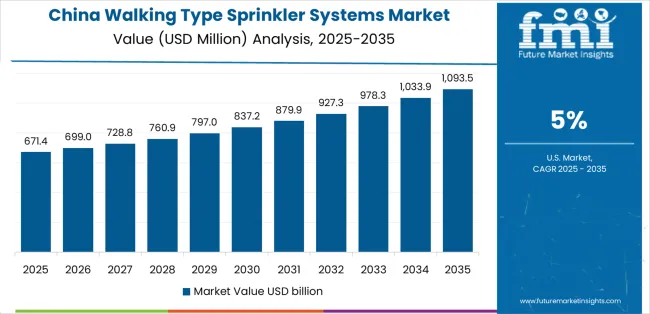
Revenue from walking type sprinkler systems in China is projected to exhibit exceptional growth with a CAGR of 5% through 2035, driven by massive agricultural modernization programs and rapidly expanding commercial farming operations supported by government rural development initiatives and agricultural infrastructure investment programs. The country's comprehensive agricultural transformation and increasing mechanization adoption are creating substantial demand for efficient irrigation solutions. Major agricultural equipment manufacturers and irrigation companies are establishing comprehensive walking sprinkler production capabilities to serve both domestic markets and export opportunities.
Revenue from walking type sprinkler systems in India is expanding at a CAGR of 4.6%, supported by expanding agricultural mechanization initiatives, growing irrigation infrastructure development, and increasing emphasis on water-efficient farming practices driven by government agricultural modernization programs and irrigation expansion projects. The country's comprehensive agricultural development initiatives and increasing mechanization adoption are driving sophisticated walking sprinkler capabilities throughout diverse farming regions. Leading agricultural equipment suppliers and irrigation companies are establishing production and distribution facilities to address growing domestic demand.
Revenue from walking type sprinkler systems in Germany is expanding at a CAGR of 4.3%, supported by the country's precision agriculture leadership, sustainable farming practices, and strong emphasis on environmental stewardship and resource efficiency. The nation's agricultural innovation and environmental consciousness are driving sophisticated walking sprinkler capabilities throughout farming operations. Leading agricultural technology companies and irrigation specialists are investing extensively in advanced irrigation systems and precision agriculture integration.
Revenue from walking type sprinkler systems in Brazil is expanding at a CAGR of 3.9%, supported by the country's large-scale agricultural expansion, growing commercial crop production, and increasing irrigation infrastructure investments driven by agricultural export growth and farming intensification. The nation's agricultural development and commercial farming growth are driving demand for mechanized irrigation solutions. Agricultural producers and irrigation companies are investing in modern irrigation equipment to support production expansion.
Revenue from walking type sprinkler systems in the United States is expanding at a CAGR of 3.5%, supported by the country's focus on agricultural efficiency optimization, water conservation regulations, and growing emphasis on sustainable farming practices and resource stewardship. The nation's comprehensive agricultural sector and irrigation technology leadership are driving demand for advanced walking sprinkler solutions. Agricultural producers and irrigation companies are investing in efficient irrigation equipment to support production sustainability.
Revenue from walking type sprinkler systems in the United Kingdom is expanding at a CAGR of 3.1%, driven by the country's sustainable agriculture emphasis, irrigation infrastructure modernization, and focus on environmental stewardship and farm productivity enhancement. The UK's agricultural innovation and environmental standards are driving walking sprinkler adoption throughout farming operations. Agricultural producers and irrigation specialists are establishing comprehensive irrigation capabilities for operational excellence.
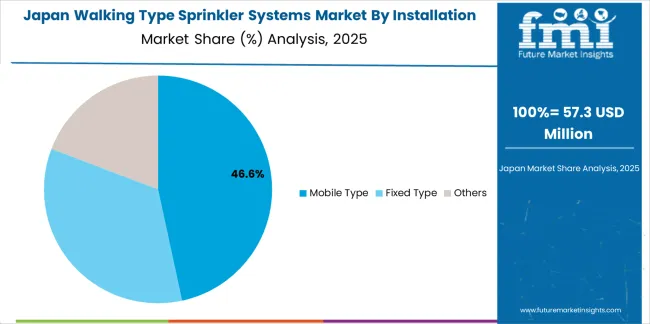
Revenue from walking type sprinkler systems in Japan is expanding at a CAGR of 2.8%, supported by the country's agricultural intensification efforts, precision farming technology adoption, and strong emphasis on production efficiency and quality standards. Japan's technological sophistication and agricultural innovation are driving demand for advanced walking sprinkler products. Leading agricultural companies are investing in specialized irrigation capabilities for intensive farming applications.

The walking type sprinkler systems market in Europe is projected to grow from USD 398.2 million in 2025 to USD 554.5 million by 2035, registering a CAGR of 3.3% over the forecast period. Germany is expected to maintain leadership with a 26.2% market share in 2025, moderating to 25.7% by 2035, supported by precision agriculture excellence, sustainable farming practices, and advanced irrigation technology integration.
France follows with 19.8% in 2025, projected at 20.3% by 2035, driven by agricultural modernization programs, irrigation infrastructure development, and emphasis on water-efficient farming practices. The United Kingdom holds 16.4% in 2025, reaching 16.1% by 2035 on the back of sustainable agriculture initiatives and irrigation system upgrades. Italy commands 14.7% in 2025, rising slightly to 15% by 2035, while Spain accounts for 11.3% in 2025, reaching 11.6% by 2035 aided by agricultural irrigation expansion and specialty crop production growth. The Netherlands maintains 4.9% in 2025, up to 5.1% by 2035 due to intensive agriculture practices and precision irrigation adoption. The Rest of Europe region, including Nordics, Central & Eastern Europe, and other markets, is anticipated to hold 6.7% in 2025 and 6.2% by 2035, reflecting steady development in agricultural modernization and irrigation infrastructure programs.
The walking type sprinkler systems market is characterized by competition among established agricultural irrigation equipment manufacturers, specialized walking sprinkler producers, and regional irrigation technology companies. Companies are investing in product innovation, water distribution technology development, smart irrigation integration, and application-specific engineering services to deliver high-performance, reliable, and cost-effective walking sprinkler solutions. Innovation in energy-efficient drive systems, precision water application technologies, and digital irrigation management capabilities is central to strengthening market position and competitive advantage.
Rmirrigation offers comprehensive walking type sprinkler solutions with focus on agricultural applications, operational reliability, and extensive product range across diverse farming and orchard operations. Lindsay Corporation provides innovative irrigation technologies with emphasis on precision agriculture integration and smart irrigation management systems. Opal Pivot delivers versatile walking sprinkler products with focus on water efficiency and operational simplicity. Atlantis offers engineered irrigation solutions for specialized agricultural applications. Valmont Industries provides comprehensive irrigation equipment with global market presence and advanced technology capabilities. Visser specializes in precision irrigation systems for horticultural applications. BAUER GmbH focuses on engineering excellence and product durability for demanding agricultural environments.
T-L Irrigation delivers continuous-move irrigation systems with emphasis on operational efficiency. Senninger provides precision irrigation components and spray technologies. Irriline offers specialized irrigation solutions for diverse agricultural markets. BudMirGroup focuses on regional agricultural irrigation equipment production. Otech specializes in walking sprinkler technologies for orchard applications. Reinke Manufacturing provides innovative irrigation systems with advanced control capabilities. Giunti SpA offers engineering irrigation solutions with emphasis on Mediterranean agricultural applications.
Walking type sprinkler systems represent a specialized agricultural irrigation equipment segment within farming operations, projected to grow from USD 1.7 billion in 2025 to USD 2.4 billion by 2035 at a 3.7% CAGR. These mechanized irrigation systems-primarily configured for mobile and fixed installation applications—serve as critical water management solutions in farms and orchards where efficient irrigation coverage, labor reduction, and consistent water application are essential. Market expansion is driven by increasing agricultural mechanization, growing water scarcity challenges, expanding commercial farming operations, and rising demand for labor-efficient irrigation solutions across diverse agricultural segments.
How Agricultural Regulators Could Strengthen Equipment Standards and Water Management?
How Industry Associations Could Advance Technology Standards and Market Development?
How Walking Type Sprinkler Systems Manufacturers Could Drive Innovation and Market Leadership?
How Agricultural Producers Could Optimize Irrigation Performance and Water Management?
How Research Institutions Could Enable Technology Advancement?
How Investors and Financial Enablers Could Support Market Growth and Innovation?
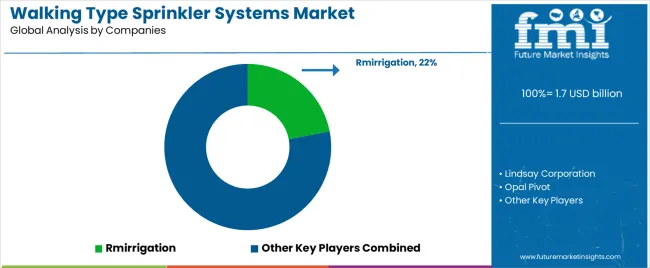
| Items | Values |
|---|---|
| Quantitative Units (2025) | USD 1.7 billion |
| Installation Type | Mobile Type, Fixed Type, Others |
| Application | Farms, Orchards |
| Regions Covered | East Asia, Europe, North America, South Asia, Latin America, Middle East & Africa, Eastern Europe |
| Countries Covered | China, India, Germany, Brazil, United States, United Kingdom, Japan, and 40+ countries |
| Key Companies Profiled | Rmirrigation, Lindsay Corporation, Opal Pivot, Atlantis, Valmont Industries, Visser, BAUER GmbH, T-L Irrigation, Senninger, Irriline, BudMirGroup, Otech, Reinke Manufacturing, Giunti SpA |
| Additional Attributes | Dollar sales by installation type and application category, regional demand trends, competitive landscape, technological advancements in walking sprinkler systems, water efficiency development, precision agriculture integration, and irrigation performance optimization |
The global walking type sprinkler systems market is estimated to be valued at USD 1.7 billion in 2025.
The market size for the walking type sprinkler systems market is projected to reach USD 2.4 billion by 2035.
The walking type sprinkler systems market is expected to grow at a 3.7% CAGR between 2025 and 2035.
The key product types in walking type sprinkler systems market are mobile type, fixed type and others.
In terms of application, farms segment to command 60.0% share in the walking type sprinkler systems market in 2025.






Our Research Products

The "Full Research Suite" delivers actionable market intel, deep dives on markets or technologies, so clients act faster, cut risk, and unlock growth.

The Leaderboard benchmarks and ranks top vendors, classifying them as Established Leaders, Leading Challengers, or Disruptors & Challengers.

Locates where complements amplify value and substitutes erode it, forecasting net impact by horizon

We deliver granular, decision-grade intel: market sizing, 5-year forecasts, pricing, adoption, usage, revenue, and operational KPIs—plus competitor tracking, regulation, and value chains—across 60 countries broadly.

Spot the shifts before they hit your P&L. We track inflection points, adoption curves, pricing moves, and ecosystem plays to show where demand is heading, why it is changing, and what to do next across high-growth markets and disruptive tech

Real-time reads of user behavior. We track shifting priorities, perceptions of today’s and next-gen services, and provider experience, then pace how fast tech moves from trial to adoption, blending buyer, consumer, and channel inputs with social signals (#WhySwitch, #UX).

Partner with our analyst team to build a custom report designed around your business priorities. From analysing market trends to assessing competitors or crafting bespoke datasets, we tailor insights to your needs.
Supplier Intelligence
Discovery & Profiling
Capacity & Footprint
Performance & Risk
Compliance & Governance
Commercial Readiness
Who Supplies Whom
Scorecards & Shortlists
Playbooks & Docs
Category Intelligence
Definition & Scope
Demand & Use Cases
Cost Drivers
Market Structure
Supply Chain Map
Trade & Policy
Operating Norms
Deliverables
Buyer Intelligence
Account Basics
Spend & Scope
Procurement Model
Vendor Requirements
Terms & Policies
Entry Strategy
Pain Points & Triggers
Outputs
Pricing Analysis
Benchmarks
Trends
Should-Cost
Indexation
Landed Cost
Commercial Terms
Deliverables
Brand Analysis
Positioning & Value Prop
Share & Presence
Customer Evidence
Go-to-Market
Digital & Reputation
Compliance & Trust
KPIs & Gaps
Outputs
Full Research Suite comprises of:
Market outlook & trends analysis
Interviews & case studies
Strategic recommendations
Vendor profiles & capabilities analysis
5-year forecasts
8 regions and 60+ country-level data splits
Market segment data splits
12 months of continuous data updates
DELIVERED AS:
PDF EXCEL ONLINE
Walking Aid Market Analysis by Product, Technology, End-user, and Region 2025 to 2035
Assisted Walking Devices Market Size and Share Forecast Outlook 2025 to 2035
Bariatric Walking Aids Market Size and Share Forecast Outlook 2025 to 2035
Type 3 Surge Protection Device Market Size and Share Forecast Outlook 2025 to 2035
Type 1 Surge Protection Device Market Size and Share Forecast Outlook 2025 to 2035
Type 2 Surge Protection Device Market Size and Share Forecast Outlook 2025 to 2035
Type 1 Commercial Surge Protection Devices Market Size and Share Forecast Outlook 2025 to 2035
Type-C Bulk Bags Market Size and Share Forecast Outlook 2025 to 2035
Competitive Overview of Type-C Bulk Bags Companies
V-type Classifiers Market Size and Share Forecast Outlook 2025 to 2035
V Type Fin Condenser Market Size and Share Forecast Outlook 2025 to 2035
V Type Air Cooled Condenser Market Size and Share Forecast Outlook 2025 to 2035
Dry-type Air-core Smoothing Reactor Market Size and Share Forecast Outlook 2025 to 2035
USB Type C Market Size and Share Forecast Outlook 2025 to 2035
Gel-Type Strong Acid Cation Exchange Resin Market Size and Share Forecast Outlook 2025 to 2035
Dry Type Distribution Transformer Market Size and Share Forecast Outlook 2025 to 2035
Dry Type Current Transformer Market Size and Share Forecast Outlook 2025 to 2035
Dry Type Automated Solar Panel Cleaning Market Size and Share Forecast Outlook 2025 to 2035
Dry Type Transformer Market Size and Share Forecast Outlook 2025 to 2035
Market Share Insights of the USB Type-C Industry

Thank you!
You will receive an email from our Business Development Manager. Please be sure to check your SPAM/JUNK folder too.
Chat With
MaRIA